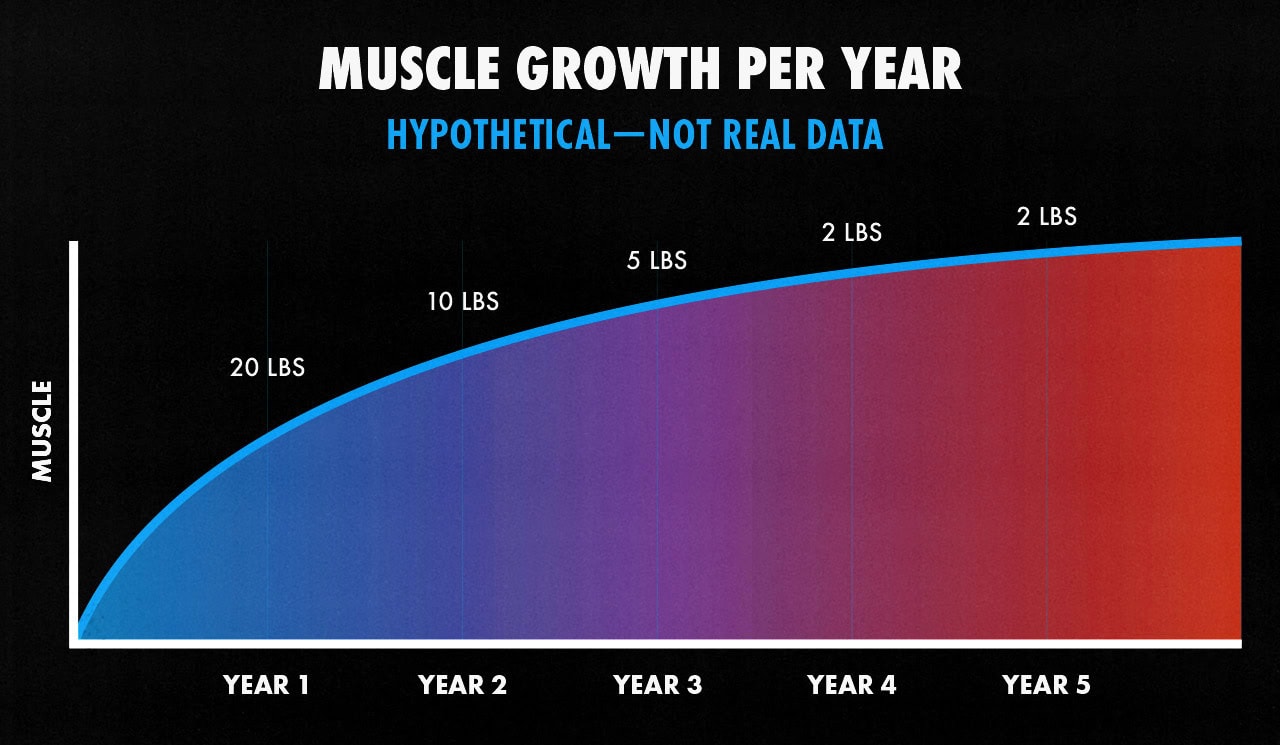
How Long Does it Take to Build Muscle?
It takes most men about a year to gain their first 20 pounds of muscle. Those first 20 pounds are enough to add 1–2 inches to your arms and bump you up a clothing size. That’s when most guys start getting compliments.
If you succeed at gaining 20 pounds in your first year, then you can gain another 10 pounds in your second year, 5 more in your third, and smaller amounts afterward.
If you fall behind schedule, your muscles will still be ready to grow. You won’t “waste” your newbie gains. When you start building muscle again, you’ll be able to build it quickly.
Let’s go over some research, examples, and exceptions. We can also debunk some common claims.
Rates of Muscle Growth in the Research
This rule of thumb lines up roughly with the research. Mind you, plenty of studies show faster rates of muscle growth. Many show slower rates. It really depends on who’s being studied and what those people are doing. Here are some of the more famous examples:
- Rozenek: men gained an average of 1 pound of muscle per week during their first 8 weeks of lifting weights (study). This was a weight gainer study. More here.
- Tarnopolsky: men gained an average of 1.1 pounds of muscle per week during their first 8 weeks of lifting weights (study). This was another weight gainer study.
- Willoughby: men gained 1.2 pounds of muscle per week during their first 10 weeks of lifting weights (study). This was a protein shake study. More on that here.
- Hartman: men gained 1.25 pounds of muscle per week during their first 12 weeks of lifting weights (study). This was a study on milk.

All of these studies show fast rates of muscle growth when guys combine weight training with liquid calories that bump people into a calorie surplus. These are bulking studies. If you want similar results from nutritious whole foods, you could add a high-calorie smoothie to your diet. Here’s how.
I suspect you can build muscle just as quickly by eating larger meals or extra snacks. The important thing is to get into a calorie surplus. However, liquid calories aren’t very filling, don’t take long to prepare, and don’t take long to drink, making it easier to get into a calorie surplus. I think that’s why these studies worked so well.

We see the opposite in intermittent fasting, vegan, and keto studies (study). The participants often struggle to build muscle because they have such a hard time eating enough calories to gain weight. We also see reduced rates of muscle growth when people cut or recomp.
The other thing to keep in mind is that muscle growth slows over time. Just because these guys got off to a fast start doesn’t mean they’d continue gaining muscle at the same rate. Plus, some of their gains came from extra food in their digestive systems, extra fluid from creatine, and extra glycogen in their muscles.*
*When you eat more calories and carbs, your muscles start to hold more energy. That energy is a type of simple sugar called glycogen. That glycogen is stored within your muscles, making them bigger and harder and improving their performance. It counts as muscle growth. However, it isn’t new muscle tissue. It’s just stored energy.
How Long Does it Take to Gain 20 Pounds?
The common rule of thumb is that it takes a year for the average man to gain his first 20 pounds of muscle. This assumes that you’re doing everything correctly. More on that in a moment.
It also assumes that you have average muscle-building genetics, you have an average frame, and you’re starting off with an average amount of muscle. To put that into context, the average American man is 5’9 and 200 pounds (reference).

Here’s where things get a bit more speculative. It seems that the further you are from your genetic muscular potential, the faster you can build muscle. This is why new lifters tend to build muscle faster than more advanced lifters. It’s also why skinny guys can build muscle faster than more athletic guys.

For example, I remember Jeff Nippard saying he started off quite muscular and then gained 25 pounds of muscle with over a decade of dedicated weight training. I started off skinny, gained 40 pounds in just over a year, and have now gained 70 pounds.

What’s happening is that I was taller, thinner, and had far more room on my frame for muscle growth. Jeff Nippard was shorter, stockier, and already closer to his genetic potential.
There are more factors at play. Some people have a more robust response to weight training than others. Even if you’re starting off with an average build, you might be able to gain 15 or perhaps 25 pounds in your first year.
And, of course, we’re assuming you’re building muscle naturally.
How Long Does it Take to Look Like You Lift?
Beginners build muscle quickly at first, and then it gradually slows over time. You might get 80% of the way to your muscular potential with 3 years of building muscle as quickly as possible (which often requires bulking). That’s almost always enough to get into great shape, look like you lift, and look optimally attractive.
How Long Does it Take to Reach Your Natural Potential?
You can get within spitting distance of your genetic potential within about 5–10 years. That’s when most guys start to look like natural bodybuilders. You can still build muscle after that, but it’s slower and more difficult, especially if you’re over 60 years old.
However, almost nobody builds muscle as quickly as their genetics allow. Most lifelong lifters never get close to their genetic potential. For a common example, most guys have the genetics to bench press 225 pounds for 8–15 reps, but most lifelong lifters can’t even bench 225 pounds for a single. For more, we have a full article on natural strength standards.
What’s the Fastest Way to Build Muscle?
To build muscle, you need to challenge your muscles enough to stimulate muscle growth, eat enough food to support that muscle growth, and get enough rest between workouts:
- You need to train for muscle growth. Callisthenics, strength training, or CrossFit don’t stimulate as much muscle growth, so you won’t grow as quickly.
- You need to challenge your muscles with enough sets and enough effort. The more time and effort you put into your workouts, the more muscle growth you’ll stimulate—to a point. It usually takes about 10–20 sets per muscle group per week. The simplest way to do that is to do 3 full-body workouts per week. You must take all those sets close (or all the way) to failure.
- You need to eat enough food to support muscle growth. If you’re overweight, then you have plenty of body fat you can burn for energy, allowing you to recomp. If you aren’t overweight, you’ll need to eat in at least a small calorie surplus. Generally, the more aggressively you gain weight, the more muscle you build, but the more fat you gain.
- Live a healthy lifestyle. That includes getting enough sleep, eating a good diet, and managing your stress. More stress isn’t necessarily a bad thing. It can even be a good thing. But you need to make sure you can gear into relaxation in the evening as you settle down for bed.

If you want a customizable workout program (and full guide) that builds on these principles, check out our Bony to Beastly (men’s) program and Bony to Bombshell (women’s) program. Or, if you’ve already gained your first 20–30 pounds, check out our Outlift Intermediate Hypertrophy Program.
Shane Duquette is the co-founder of Outlift, Bony to Beastly, and Bony to Bombshell. He's a certified conditioning coach with a degree in design from York University in Toronto, Canada. He's personally gained 70 pounds and has over a decade of experience helping over 10,000 skinny people bulk up.





Hey Shane,
Great article, always informative and encouraging. I’m wondering if you’re aware of any research on how much muscle you can expect to gain specifically while recomping?
Thanks,
Darren
Hey Darren,
That’s a really good question. I suspect it depends on how much extra fat you have, how close you are to your genetic potential, how strongly you respond to the stimulus of lifting, and how good your recomp genetics are. I know it depends on a lot, but recomping is one of those things where sometimes it works great, and sometimes it doesn’t work at all. And even when it does work great, it usually stops working at a certain point.
So you could imagine an overweight beginner who builds muscle nearly at full speed while recomping. You could also imagine a guy who isn’t quite as overweight and who doesn’t respond as well, and he barely builds any muscle at all—maybe none whatsoever.
Cutting and bulking aren’t like that. You’re pretty much guaranteed to burn fat while cutting and build muscle while bulking. Some people get better results than others, but the method is powerful enough that it basically always works well.
That’s why it’s so important to track your progress. That way, you know when recomping is working and when it breaks.